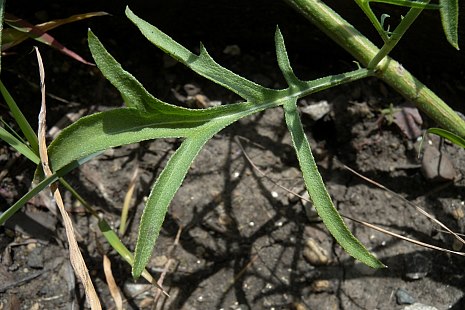Description: This perennial wildflower is 1-3' tall, branching occasionally. The stems are medium green and minutely rough-pubescent to glabrous. The spreading alternate leaves are up to 6" long and 2" across; they are pinnatifid or double-pinnatifid with 5-11 lobes, medium green, and minutely rough-pubescent to glabrous. The slender lobes are linear-oblong and sometimes have 1-2 dentate teeth or smaller cleft lobes; they are 1/3" (8 mm.) across or less. Irregularities in the structure of the leaves are rather common. The petioles are up to 2" long.

Occasionally, the
upper stems terminate in individual flowerheads on long naked stalks
(peduncles). These stalks are 2-12" long and finely grooved. The
flowerheads are about 1½–3" long and a little less across. Each
flowerhead consists of a cylindrical head of numerous disk florets,
which is surrounded by 4-11 drooping rays (ray florets). A mature head
of disk florets is ¾–1¾" long; it is initially gray or greenish gray,
later becoming dark brown. The rays are about ½–1¼" long, oblong in
shape, and slightly notched at their tips; they are either yellow,
maroon (reddish brown), or yellow with basal patches of maroon. The
typical form of Mexican Hat has yellow rays, while plants with maroon
rays are referred to as f. pulcherrima.
The bottom
of each flowerhead is defined by 2 series of small narrow bracts; these
are largely hidden by the drooping
rays. The blooming period occurs during the summer and lasts about 1-2
months. Fertile disk florets are replaced by small oblongoid achenes;
each achene usually has one or more tiny scales at its apex. This plant
spreads to new areas by reseeding itself.
Cultivation:
The preference is full sun, dry conditions, and a relatively barren
soil containing clay, gravel, or sand. On moist fertile ground, this
wildflower has trouble competing with taller and more aggressive plants.
Range & Habitat:
Mexican Hat is adventive from the the Great Plains and western states;
the eastern boundary of its range extends into western Iowa and
Missouri. In Illinois, naturalized populations of Mexican Hat are
uncommon; they are found primarily in the northern and western sections
of the state. Habitats include upland prairies, roadsides, areas along
railroads, and barren waste areas. This wildflower is often cultivated
in gardens, from which it sometimes escapes. In Illinois, Mexican Hat
is found primarily in disturbed areas, where it may or may not persist.
Faunal Associations:
Various insects are attracted to the nectar and pollen of the
flowerheads. Floral visitors of Mexican Hat are probably similar to
those insects that are known to visit the flowerheads of Ratibida
pinnata (Yellow Coneflower). Likely visitors include various
short-tongued bees, wasps, flies, beetles, and the occasional butterfly
or skipper. The caterpillars of some moths are known to feed on Ratibida
spp. (primarily the rays and florets). These species include Homoeosoma
electellum (Sunflower Moth), Chlorochlamys
chloroleuca (Blackberry Looper Moth), Eupithecia
miserulata (Common Pug), Synchlora aerata
(Wavy-Lined Emerald), and Epiblema iowana
(Tortricid Moth sp.). The caterpillars of the latter moth feed on the
roots.
Photographic Location:
A flower garden in downtown Champaign, Illinois. The photographed plant
is Ratibida columnifera pulcherrima.

Comments: This is a colorful prairie wildflower. Mexican Hat can be distinguished from Ratibida pinnata (Yellow Coneflower) by its long cylindrical heads, which usually exceed the length of the rays at maturity. The ovoid-globoid heads of Yellow Coneflower, in contrast, are much shorter than the length of their rays. Other common names of Ratibida columnifera are Long-Headed Coneflower and Prairie Coneflower. The common name that is used here, 'Mexican Hat,' refers to the fancied resemblance of the flowerhead to a sombrero.